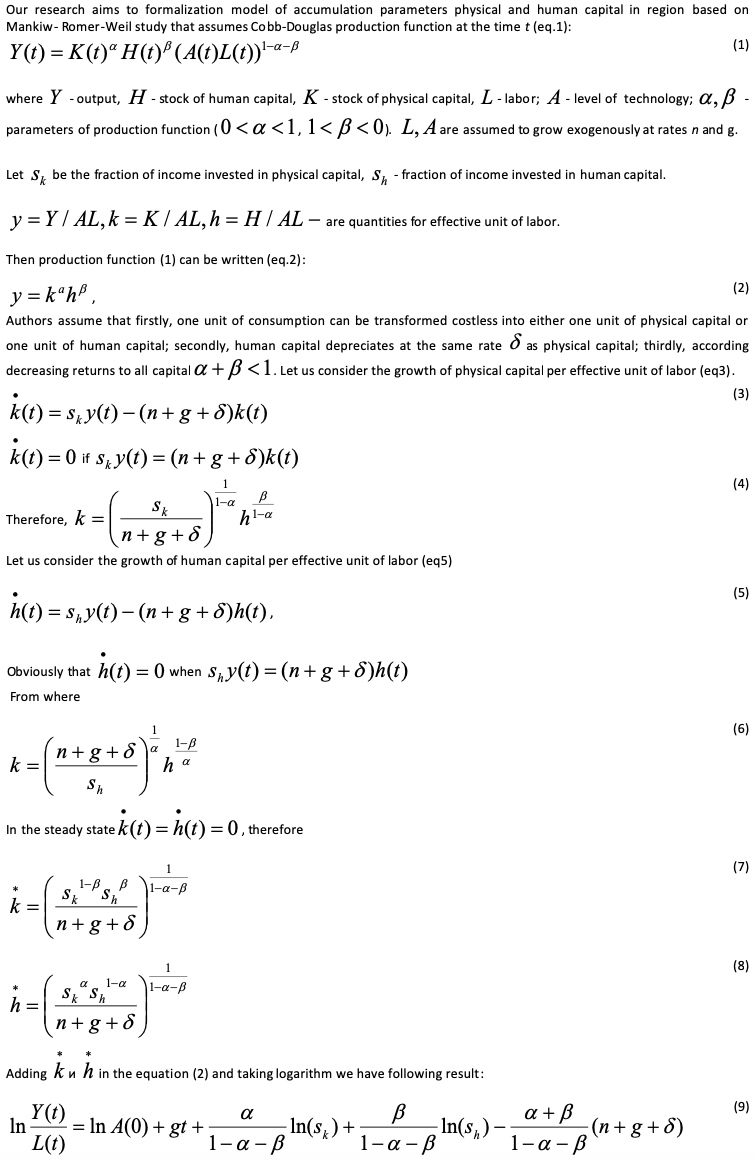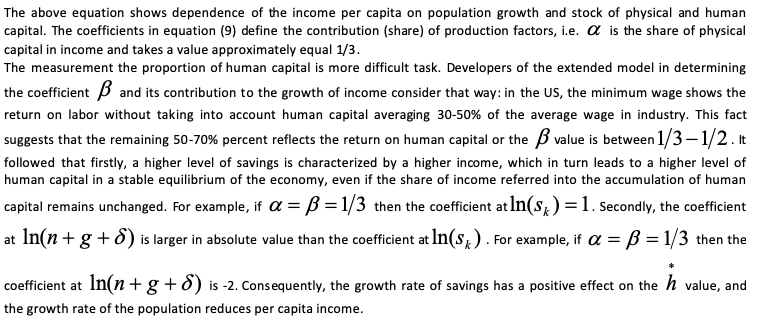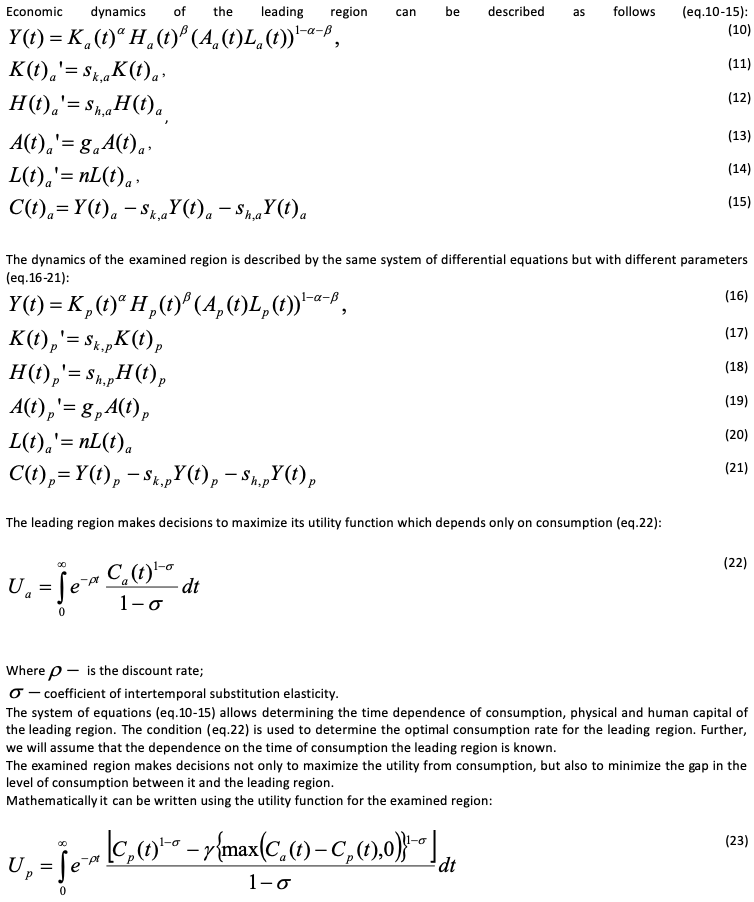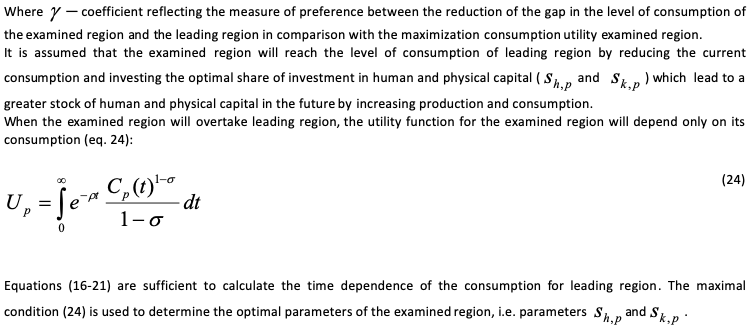

Vol. 40 (Number 35) Year 2019. Page 18
KRASNOSELSKAYA, Dina Kh. 1; KHAMZINA, Dilya R. 2; GOLOVIZNIN, Sergey M. 3; NOGOVITSINA, Olesya V. 4; SARAPULOVA, Anna V. 5 & ARISHINA, Elina S. 6
Received: 25/06/2019 • Approved: 08/10/2019 • Published 14/10/2019
ABSTRACT: The article addresses the modeling accumulation parameters of physical and human capital as the forcing drivers of regional development. To achieve this aim we applied tool of regional benchmarking. Different approaches to the interpretation of the definition «regional benchmarking» were considered; as a result we proposed our definition to clarify theoretical foundation in this study area. The model for optimizing the parameters of accumulation physical and human capital based on the Mankiw -Romer-Weil model has been proposed. |
RESUMEN: El artículo aborda los parámetros de acumulación de modelos del capital físico y humano como impulsores del desarrollo regional. Para lograr este objetivo aplicamos la herramienta de benchmarking regional. Se consideraron diferentes enfoques para determinar la interpretación de la definición «evaluación comparativa regional»; como resultado, propusimos nuestra definición para aclarar los fundamentos teóricos en esta área de estudio. Se ha propuesto el modelo para optimizar los parámetros de acumulación de capital físico y humano basado en el modelo Mankiw-Romer-Weil. |
At present there are a lot of spatial challenges Russian regions are facing. Among key of them are: socio-economical disparities in regional development, the need to reshape technological structure in order to capture innovative pathway, generation new tools of improving social well-being. Therefore in our article we shed some light by adding to emerging body of recent benchmarking studies related to regional level. We propose original approach of capital accumulation using as departure point the Mankiw -Romer-Weil model. Its application facilitates decision-making process and makes possible to decline spatial heterogeneity.
The concept of regional benchmarking has been arising in the regional science for a long time. Initially it was applied in the regional planning thanks to Lisbon strategy aimed on strengthen competiveness of countries EU union. Benchmarking is considered as the tool that gives vision referring development trends of examined region taking into account economic phenomena and processes in others regions.
There are different definitions of «regional benchmarking» proposed researchers.
For instance, Koellreuter K. (Koellreuter, 2002) defines regional benchmarking as «inter-regional comparisons of activities, processes, practices, policies and usage this information to improve regional development». Clary , G. Grootendorst, K. Nichols (Clary, Grootendorst, Nichols, 2009) reveal the contex of benchmarking as an assessment of the region¢s development using an extensive list of indicators.
Berde A. (Berde, 2008) refers benchmarking to universal tool with which economic entities evaluate their activities in comparison with the best in its class, determine the methods and means of achieving a high level development.
According to the international consulting agency BAK Basel Economics (Eichler, 2007) regional benchmarking is a "process consisting in establishing a list of various indicators and comparing indicators of the region with these ones". Оn our opinion regional benchmarking is a systematic activity of collecting, analyzing, choosing the best indicators of the regions and developing tools (programs, schemes, models) to achieve them.
Having analyzed action-oriented researches on regional benchmarking we can highlight involving integral indexes for estimation of territorial development (table 1).
Table 1
Integral indexes in benchmarking studies
Authors |
Reseach aim |
Directions for measuring |
Atkinson R., Andes S. |
Measurement of the regional structure, its assessment with regard to the ideal benchmark structure |
Jobs requiring high qualification and professional knowledge, globalization, economic dynamism, digital economy, innovative opportunities |
DeVol R., Bedroussian A., Klowden K., Hynek C. |
Identification the most successful cities in terms of creating and maintaining jobs as well as analyzing the quality of jobs and the economic development of urban entities |
GDP, average wages, concentration and diversification technological industries
|
Huggins R., Izushi H. |
Assessment of the economic competitiveness in the regions and neighborhoods United Kingdom |
Cost and production factors |
Eberts R., Erickcek G., Kleinhenz J. |
Understanding regional economic processes and tracking the region¢s economic development |
Skilled labor, urban assimilation, race structure population, sustainability territories, income distribution, local territorial particularities, business dynamics, territory structure |
Source: own processing
As above mention table 1 shows there are variety of indicators can be involved for regional benchmarking. In our opinion benchmarking is a universal tool that can be used in different ways referred to regional development.
Russian scientists have a few studies on benchmarking tools adapted to regional scale. For instance, Ivanov P. (Ivanov, 2017) considers comparative analysis within life cycle of the territory. Klimova N., Krasnoselskaya D.Kh. explore the performance of oil companies using benchmark values (Klimova, Krasnoselskaya, Khamzina, 2018). Yusupov K., Timir’yanova V. (Yusupov, Timir’yanova, 2018) assesses spatial hierarchical impacts on municipal unities. Danilova I., Karetnikova I. (Danilova, Karetnikova, 2016) propose the original methodical approach to evaluate competitive power of companies and industries.
At present one of the most important aims for Russian Federation is to transition to innovative economy accompanied by forming and effective using human capital. Therefore in this paper we formalize model that allows region to choose optimal structure of capital based on indicators leading region.
Originally, Mankiw- Romer-Weil model was created by including the human capital as well a physical capital into classic Solow's model to provide better understanding of differences in income per capita across countries. Authors proved that this model better fits cross-countries data in comparison with the latter one. They use three samples of countries covering data from 1960 to 1985: countries that are not oil producers, countries having average rates of development and OESD countries.
Results showed that human capital is significant for all samples; it gravely increases the quality of examined model. Adding a human capital as explanatory variable allowed to explain the 80% of cross-countries variance in GDP per capita attributed to not oil producing countries and countries with average rates of development.


We propose model of setting optimal ratios human and physical capital using benchmarking tool. To formalize this model we introduce the following denotations. The leading region is described by functions and parameters with the “a” index, the examined region is described with the “p” index.


The proposed model can be used to predict the development of regional socio-economic systems in the field of capital accumulation, optimization of current consumption bearing in mind sectoral structure, institutional restrictions and business climate. But it is noteworthy to define some shortcomings of method. Firstly, significant spatial heterogeneity and huge square of Russian Federation require justifying criteria for region's comparison. Secondly, the chosen indicators should be embedded into regional programs to provide data for decision-making process.
The findings of model's application should be useful in the development programs and activities both at federal and regional scales to update fixed assets, create and maintain the necessary conditions for the full reproduction of human capital. The use of benchmarking as a promising tool for solving problems of a spatial planning assumes further elaboration of its organizational and methodological issues and evaluating the economic application effects.
Atkinson R., Andes S. (2010) The 2010 State New Economy Index: Benchmarking Economic Transformation in the States. P.64.
Berde, A. Regional benchmarking process in cognac project (Coordination of RDI policies and their coherence with other policies in the Newly Acceded Countries) / Berde A., Nadaban M.V.− Agroinform Publishing House, 2008. − 32 p.
Clary, J. Hampton Roads Regional Benchmarking Study Fiscal Year 2009 / J. Clary , G. Grootendorst, K. Nichols. − Hampton Roads Planning District Comission, 2009. − 113 p.
Danilova I., Karetnikova T. (2016) Сompetitive power of companies and industries: a methodical approach to evaluation. Indian Journal of Science and Technology, 9 (36), 102-119.
DeVol R., Bedroussian A., Klowden K., Hynek C. Best-Performing Cities 2010. Where America’s Jobs Are Created and Sustained. October 2010. P. 61.
Eberts R., Erickcek G., Kleinhenz J. Dashboard Indicators for the Northeast Ohio Economy. April 2006. P. 47.
Eichler M. Brussels Metropolitan Region Benchmarking Analysis 2007. BAK Basel Economics., 2007. − 85 p.
Huggins R., Izushi H. UK Competitiveness Index 2008. P. 55.
Ivanov P.A. (2017). Evaluation of life cycle of the territory (on the exapmle of municipal entities of Republic of Bashkortostan). Azimuth of Scientific Research: Economics and Administration, 3 (20), 160-163.
Klimova, N.I., Krasnoselskaya, D.Kh., Khamzina, D.R. (2018). An empirical study on the relationships between sales revenue of oil company and industry specific and exogenous characteristics. Journal of Applied Economic Sciences, Volume XIII, Winter, 8(62): 2261 – 2268.
Koellreuter, С. Regional Benchmarking as a tool to improveregional foresight. European Commission / С. Koellreuter. − Research DG-Directorate K, 2002. − 14 p
Mankiw G., Romer D., Weil D. (1999). A contribution to empirics of economic growth. The Quarterly Journal of Economics, 107 (2), 407−437.
Yusupov K.N., Timiryanova V.M., Toktamysheva Yu.S., Popov D.V. (2018) Hierarchical and spatial effects in the development of municipalities, Economic and Social Changes: Facts, Trends, Forecast, 11(5), 137-154. DOI: 10.15838/esc.2018.5.59.9
1. Ufa State Petroleum Technological University , dina-hamzina@mail.ru
2. Nosov Magnitogorsk State Technical University, Russian Federation
3. Nosov Magnitogorsk State Technical University, Russian Federation
4. Nosov Magnitogorsk State Technical University, Russian Federation
5. Nosov Magnitogorsk State Technical University, Russian Federation
6. Nosov Magnitogorsk State Technical University, Russian Federation